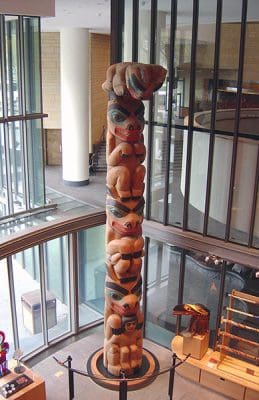Between 1904 and 1942, New York City visitors could see two amazing Native American artifacts on the east bank of the Wild Fowl Pond at the Bronx Zoo. The unfamiliar sites were a totem pole and a chief’s house from Alaska’s Tlingit native tribe. These artifacts, made of red cedar are depicted on two of the many postcards published before the first World War by the zoo’s administration.
The totem pole and clan house found their beginnings in the coastal village of Gaash on Cape Fox, near present day Ketchikan, Alaska. These rare items were gifted to the zoo (then known as the New York Zoological Park) by the American railway tycoon Edward Harriman, who had financed an 1899 expedition to Alaska that visited the seemingly abandoned coastal village.
Members of the expedition dismantled Chief’s Thomas Johnson’s Brown Bear Clan House and the pole in front of it named Hoots Kooteeya. They then loaded the pieces (along with five other poles and various indigenous artifacts), onto Harriman’s steamer the George W. Elder. The Elder set sail in time to arrive in Seattle on July 30th.
John Muir, the founder of the American conservation movement, was the only member of the expedition to protest the appropriation of cultural artifacts without permission. The removal of these artifacts from Alaska was not viewed, by the others, as a morally troubling act or as a theft.
Due to a smallpox epidemic years before, the tribe had moved to the nearby village of Saxman, but the tribe did not consider Fox Gaash as abandoned. Over the next several years the disputed artifacts were distributed to various institutions across the United States. In addition to the New York Zoological Park, other institutions that received donations from Harriman included the Smithsonian Institution, Cornell University, Harvard University, and Smith College.
The expedition party was made up of many distinguished experts including the young American photographer and ethnologist Edward Curtis, who is famous for his portraits of American Indians. A published portfolio of expedition photos by Curtis includes a fine image of this Tlingit totem pole and the house.
The official report for New York City Parks for the year 1904 considered … these two objects together form a very striking and instructive exhibit and constitute a valuable feature of the educational exhibits of the Zoological Park.
In 1942 the Bronx Zoo cleaned house and remodeled its exhibits. The fate of the Chief’s House is unknown, but the totem pole was transferred to the Museum of the American Indian (now the National Museum of the American Indian) which placed it on the grounds of their storage and research facility in the East Bronx. There it welcomed scholars and museum employees who worked at the facility. In the 1980s after four decades of exposure to weather and outside elements its condition had deteriorated, and it was placed in storage.
The Tlingit Indians, however, had never forgotten the Hoots Kooteeya pole and the way it had been taken from their land. In 1995, as the planning for the new National Museum of the American Indian was underway, officials of the Cape Fox Village Corporation, representing the descendants of Gaash’s Brown Bear Clan, asked for the return of the totem pole and other objects from the Harriman expedition under the museum’s repatriations program. The provenance of these artifacts was not in doubt, and the museum happily obliged. By July 2001, the Hoots Kooteeya pole had been carefully packed and returned to Alaska.
A similar totem pole of a bear peering from its den, also taken by the Harriman Expedition, was likewise repatriated by this tribe in 2001 from the Peabody Museum at Harvard University. This and similar actions by other institutions had followed the passage in 1990 by Congress, after years of tribal activism, of the Native American Graves and Repatriation Act. The act stipulates that museums receiving federal funds must return cultural property to native groups with legitimate claims.

The story of the Hoots Kooteeya pole does not end with its repatriation, for these repatriations have given rise to the fitting practice of creating replica totem poles by preeminent native carvers such as Nathan Jackson and his son Stephen Jackson. The new carvings replace, in museum collections, the returned ones. In this case Nathan Jackson created a new design paying tribute to the earlier Hoots Kooteeya pole, twenty feet tall by two feet wide. It is now part of the permanent collection of the National Museum of the American Indian in Washington, D. C. and illustrates the Tlinget story of Kaats, a very unlucky bear hunter.
If you care to see photographs of the reassembled totem and clan house there are several at this internet link: https://sova.si.edu/record/nmai.ac.204#digital_content.
**


My maternal grandmother knew Mary Averell Harriman Fisk, one of Edward Harriman’s grandchildren.